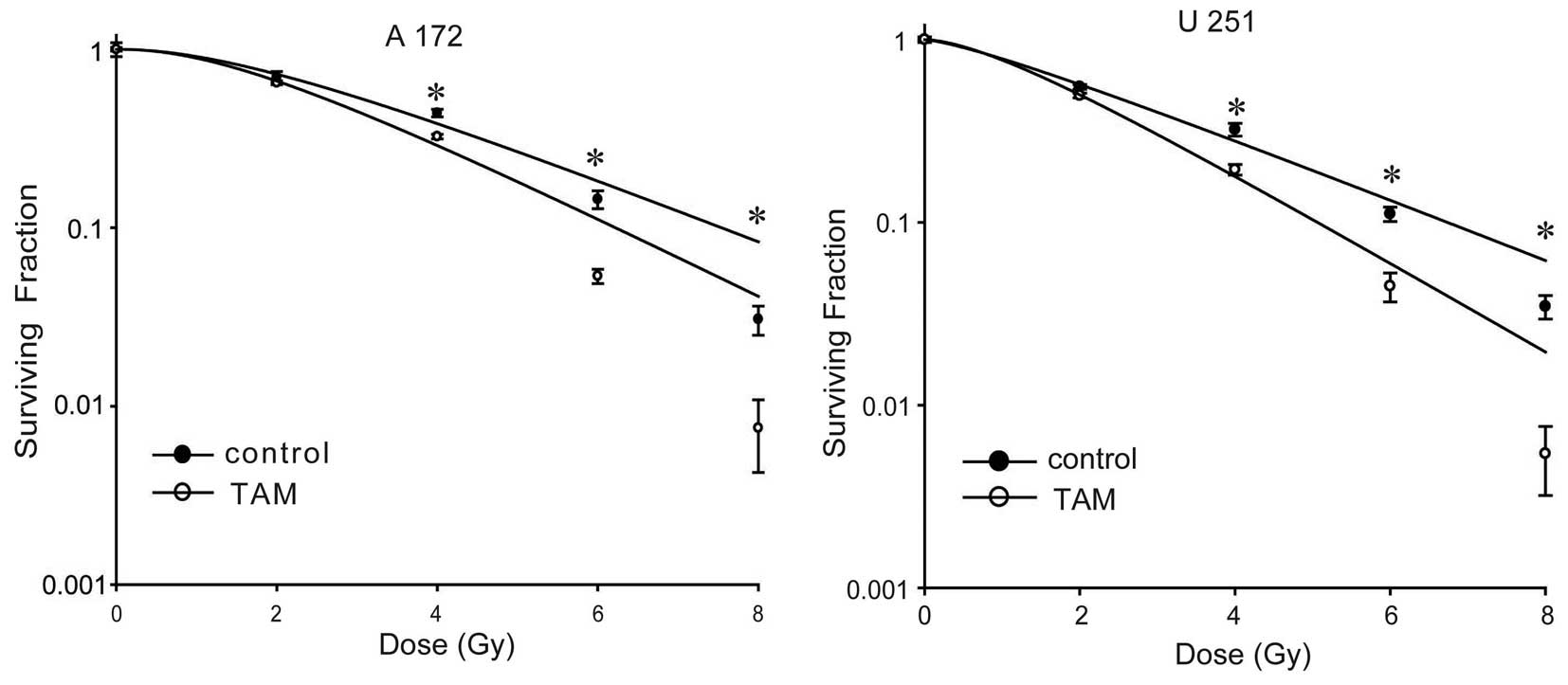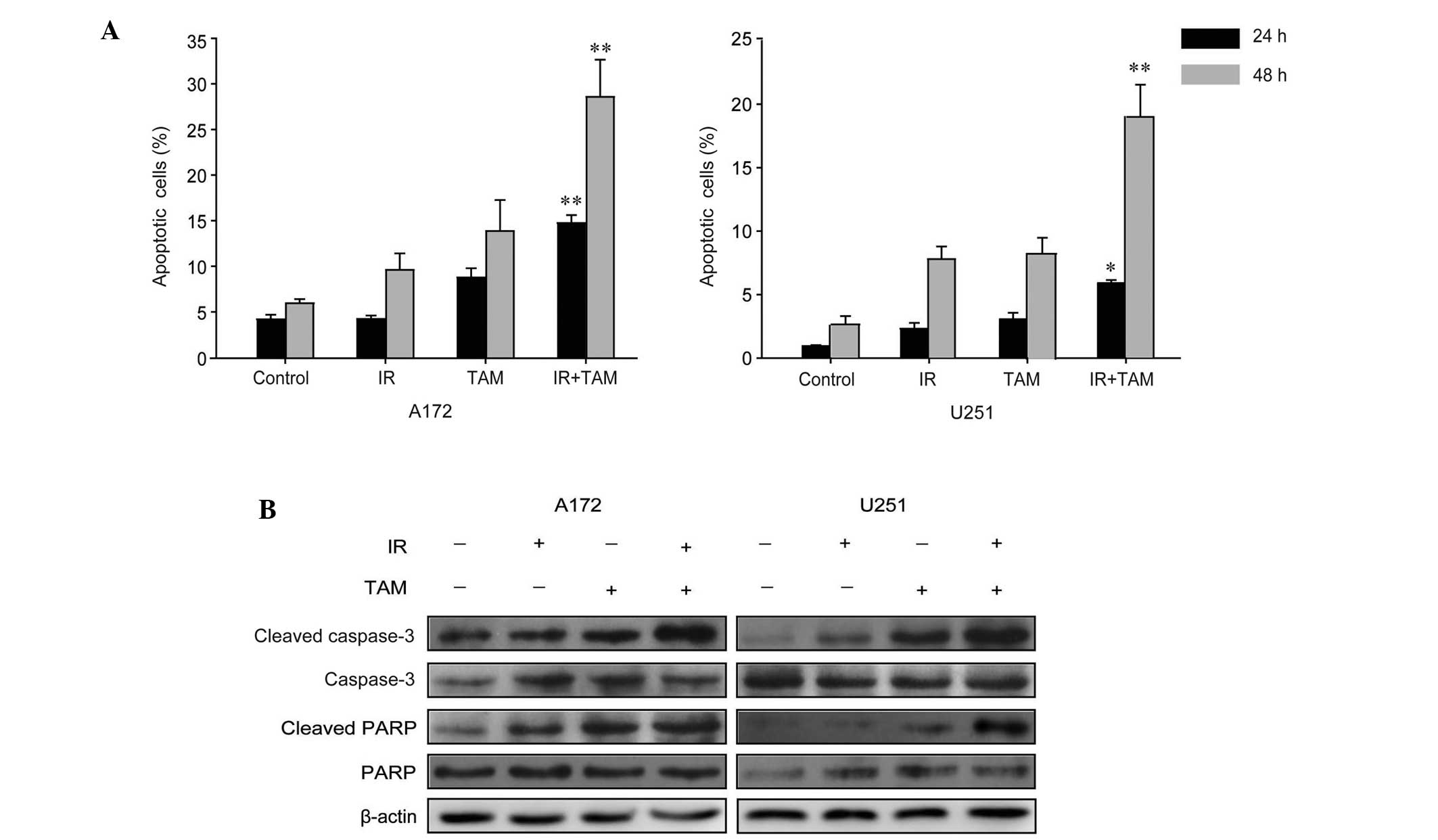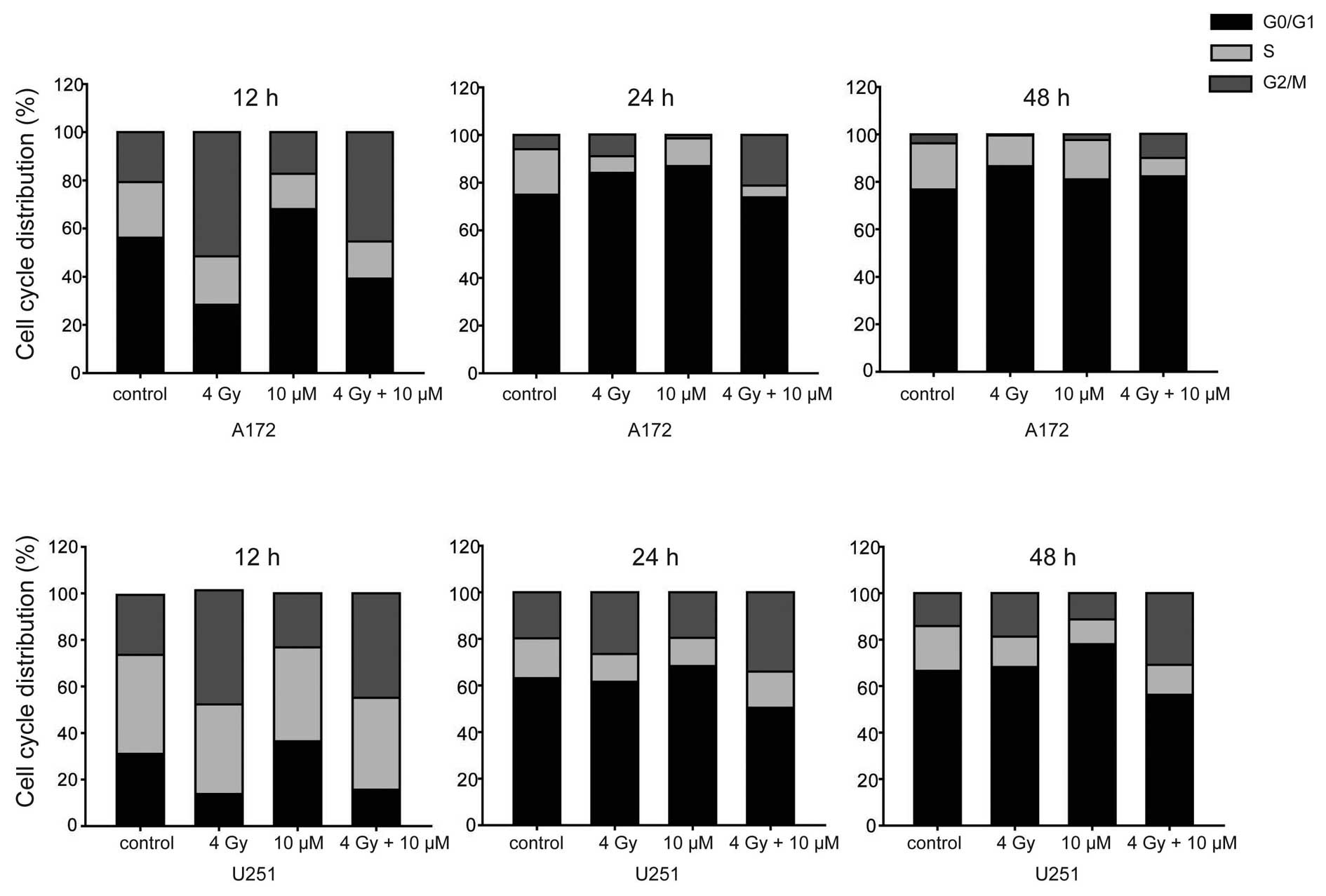|
1
|
Parlato C, Barbarisi M, Moraci M and
Moraci A: Surgery, radiotherapy and temozolomide in treating
high-grade gliomas. Front Biosci. 11:1280–1283. 2006. View Article : Google Scholar : PubMed/NCBI
|
|
2
|
Stupp R, Mason WP, van den Bent MJ, et al:
Radiotherapy plus concomitant and adjuvant temozolomide for
glioblastoma. N Engl J Med. 352:987–996. 2005. View Article : Google Scholar : PubMed/NCBI
|
|
3
|
Laperriere N, Zuraw L and Cairncross G:
Cancer Care Ontario Practice Guidelines Initiative Neuro-Oncology
Disease Site Group: Radiotherapy for newly diagnosed malignant
glioma in adults: a systematic review. Radiother Oncol. 64:259–273.
2002. View Article : Google Scholar : PubMed/NCBI
|
|
4
|
Wild-Bode C, Weller M, Rimner A, Dichgans
J and Wick W: Sublethal irradiation promotes migration and
invasiveness of glioma cells: implications for radiotherapy of
human glioblastoma. Cancer Res. 61:2744–2750. 2001.PubMed/NCBI
|
|
5
|
Pu YS, Hsieh TS, Tsai TC, et al: Tamoxifen
enhances the chemosensitivity of bladder carcinoma cells. J Urol.
154:601–605. 1995. View Article : Google Scholar : PubMed/NCBI
|
|
6
|
Liu Z, Kokunai T and Tamaki N: Tamoxifen
interacts with NEU/C-ERBB-2 receptor and inhibits growth of human
malignant glioma cell lines. Kobe J Med Sci. 47:131–140.
2001.PubMed/NCBI
|
|
7
|
Kohli L, Kaza N, Coric T, et al:
4-Hydroxytamoxifen induces autophagic death through K-Ras
degradation. Cancer Res. 73:4395–4405. 2013. View Article : Google Scholar : PubMed/NCBI
|
|
8
|
Ribeiro MP, Silva FS, Paixão J, Santos AE
and Custódio JB: The combination of the antiestrogen endoxifen with
all-trans-retinoic acid has anti-proliferative and anti-migration
effects on melanoma cells without inducing significant toxicity in
non-neoplasic cells. Eur J Pharmacol. 715:354–362. 2013. View Article : Google Scholar : PubMed/NCBI
|
|
9
|
Wilking N, Appelgren LE, Carlstrom K,
Pousette A and Theve NO: The distribution and metabolism of
14C-labelled tamoxifen in spayed female mice. Acta Pharmacol
Toxicol (Copenh). 50:161–168. 1982. View Article : Google Scholar : PubMed/NCBI
|
|
10
|
Gundimeda U, Chen ZH and Gopalakrishna R:
Tamoxifen modulates protein kinase C via oxidative stress in
estrogen receptor-negative breast cancer cells. J Biol Chem.
271:13504–13514. 1996. View Article : Google Scholar : PubMed/NCBI
|
|
11
|
Horgan K, Cooke E, Hallett MB and Mansel
RE: Inhibition of protein kinase C mediated signal transduction by
tamoxifen. Importance for antitumour activity. Biochem Pharmacol.
35:4463–4465. 1986. View Article : Google Scholar : PubMed/NCBI
|
|
12
|
Kang Y, Cortina R and Perry RR: Role of
c-myc in tamoxifen-induced apoptosis estrogen-independent breast
cancer cells. J Natl Cancer Inst. 88:279–284. 1996. View Article : Google Scholar : PubMed/NCBI
|
|
13
|
Mandlekar S and Kong AN: Mechanisms of
tamoxifen-induced apoptosis. Apoptosis. 6:469–477. 2001. View Article : Google Scholar : PubMed/NCBI
|
|
14
|
Nakadate T, Jeng AY and Blumberg PM:
Comparison of protein kinase C functional assays to clarify
mechanisms of inhibitor action. Biochem Pharmacol. 37:1541–1545.
1988. View Article : Google Scholar : PubMed/NCBI
|
|
15
|
Ramachandran C, Khatib Z, Petkarou A, et
al: Tamoxifen modulation of etoposide cytotoxicity involves
inhibition of protein kinase C activity and insulin-like growth
factor II expression in brain tumor cells. J Neurooncol. 67:19–28.
2004. View Article : Google Scholar : PubMed/NCBI
|
|
16
|
O'Brian CA, Liskamp RM, Solomon DH and
Weinstein IB: Inhibition of protein kinase C by tamoxifen. Cancer
Res. 45:2462–2465. 1985.PubMed/NCBI
|
|
17
|
Xiao H, Goldthwait DA and Mapstone T: The
identification of four protein kinase C isoforms in human
glioblastoma cell lines: PKC α, γ, ε and ζ. J Neurosurg.
81:734–740. 1994. View Article : Google Scholar : PubMed/NCBI
|
|
18
|
Zhang W, Yamada H, Sakai N, Niikawa S and
Nozawa Y: Enhancement of radiosensitivity by tamoxifen in C6 glioma
cells. Neurosurgery. 31:725–729; discussion 729–730. 1992.
View Article : Google Scholar : PubMed/NCBI
|
|
19
|
Couldwell WT, Uhm JH, Antel JP and Yong
VW: Enhanced protein kinase C activity correlates with the growth
rate of malignant gliomas in vitro. Neurosurgery. 29:880–886;
discussion 886–887. 1991. View Article : Google Scholar : PubMed/NCBI
|
|
20
|
Couldwell WT, Antel JP and Yong VW:
Protein kinase C activity correlates with the growth rate of
malignant gliomas: Part II. Effects of glioma mitogens and
modulators of protein kinase C. Neurosurgery. 31:717–724,
discussion 724. 1992. View Article : Google Scholar : PubMed/NCBI
|
|
21
|
Baltuch GH and Yong VW: Signal
transduction for proliferation of glioma cells in vitro occurs
predominantly through a protein kinase C-mediated pathway. Brain
Res. 710:143–149. 1996. View Article : Google Scholar : PubMed/NCBI
|
|
22
|
Inoue M, Kishimoto A, Takai Y and
Nishizuka Y: Studies on a cyclic nucleotide-independent protein
kinase and its proenzyme in mammalian tissues. II. Proenzyme and
its activation by calcium-dependent protease from rat brain. J Biol
Chem. 252:7610–7616. 1977.PubMed/NCBI
|
|
23
|
Kishimoto A, Takai Y, Mori T, Kikkawa U
and Nishizuka Y: Activation of calcium and phospholipid-dependent
protein kinase by diacylglycerol, its possible relation to
phosphatidylinositol turnover. J Biol Chem. 255:2273–2276.
1980.PubMed/NCBI
|
|
24
|
Castagna M, Takai Y, Kaibuchi K, Sano K,
Kikkawa U and Nishizuka Y: Direct activation of calcium-activated,
phospholipid-dependent protein kinase by tumor-promoting phorbol
esters. J Biol Chem. 257:7847–7851. 1982.PubMed/NCBI
|
|
25
|
Regala RP, Weems C, Jamieson L, Copland
JA, Thompson EA and Fields AP: Atypical protein kinase Cι plays a
critical role in human lung cancer cell growth and tumorigenicity.
J Biol Chem. 280:31109–31115. 2005. View Article : Google Scholar : PubMed/NCBI
|
|
26
|
Takagawa R, Akimoto K, Ichikawa Y, et al:
High expression of atypical protein kinase C λ/ι in gastric cancer
as a prognostic factor for recurrence. Ann Surg Oncol. 17:81–88.
2010. View Article : Google Scholar : PubMed/NCBI
|
|
27
|
Desai SR, Pillai PP, Patel RS, McCray AN,
Win-Piazza HY and Acevedo-Duncan ME: Regulation of Cdk7 activity
through a phosphatidylinositol (3)-kinase/PKC-ι-mediated signaling
cascade in glioblastoma. Carcinogenesis. 33:10–19. 2012. View Article : Google Scholar : PubMed/NCBI
|
|
28
|
Patel R, Win H, Desai S, Patel K, Matthews
JA and Acevedo-Duncan M: Involvement of PKC-ι in glioma
proliferation. Cell Prolif. 41:122–135. 2008. View Article : Google Scholar : PubMed/NCBI
|
|
29
|
Donson AM, Weil MD and Foreman NK:
Tamoxifen radiosensitization in human glioblastoma cell lines. J
Neurosurg. 90:533–536. 1999. View Article : Google Scholar : PubMed/NCBI
|
|
30
|
Desai S, Pillai P, Win-Piazza H and
Acevedo-Duncan M: PKC-ι promotes glioblastoma cell survival by
phosphorylating and inhibiting BAD through a phosphatidylinositol
3-kinase pathway. Biochim Biophys Acta. 1813:1190–1197. 2011.
View Article : Google Scholar : PubMed/NCBI
|
|
31
|
Jackson SP and Bartek J: The DNA-damage
response in human biology and disease. Nature. 461:1071–1078. 2009.
View Article : Google Scholar : PubMed/NCBI
|
|
32
|
He J, Li J, Ye C, et al: Cell cycle
suspension: a novel process lurking in G2 arrest. Cell Cycle.
10:1468–1476. 2011. View Article : Google Scholar : PubMed/NCBI
|
|
33
|
Gaikwad NW and Bodell WJ:
Peroxidase-mediated dealkylation of tamoxifen, detected by
electrospray ionization-mass spectrometry and activation to form
DNA adducts. Free Radic Biol Med. 52:340–347. 2012. View Article : Google Scholar : PubMed/NCBI
|
|
34
|
Baldwin RM, Garratt-Lalonde M, Parolin DA,
Krzyzanowski PM, Andrade MA and Lorimer IA: Protection of
glioblastoma cells from cisplatin cytotoxicity via protein kinase
Cι-mediated attenuation of p38 MAP kinase signaling. Oncogene.
25:2909–2919. 2006. View Article : Google Scholar : PubMed/NCBI
|
|
35
|
Baldwin RM, Parolin DA and Lorimer IA:
Regulation of glioblastoma cell invasion by PKCι and RhoB.
Oncogene. 27:3587–3595. 2008. View Article : Google Scholar : PubMed/NCBI
|
|
36
|
Schachter MM and Fisher RP: The
CDK-activating kinase Cdk7: taking yes for an answer. Cell Cycle.
12:3239–3240. 2013. View
Article : Google Scholar : PubMed/NCBI
|
|
37
|
Bicaku E, Patel R and Acevedo-Duncan M:
Cyclin-dependent kinase activating kinase/Cdk7 co-localizes with
PKC-ι in human glioma cells. Tissue Cell. 37:53–58. 2005.
View Article : Google Scholar : PubMed/NCBI
|
|
38
|
Larochelle S, Merrick KA, Terret ME, et
al: Requirements for Cdk7 in the assembly of Cdk1/cyclin B and
activation of Cdk2 revealed by chemical genetics in human cells.
Mol Cell. 25:839–850. 2007. View Article : Google Scholar : PubMed/NCBI
|
|
39
|
Yu J, Guo QL, You QD, et al: Gambogic
acid-induced G2/M phase cell-cycle arrest via disturbing
CDK7-mediated phosphorylation of CDC2/p34 in human gastric
carcinoma BGC-823 cells. Carcinogenesis. 28:632–638. 2007.
View Article : Google Scholar : PubMed/NCBI
|













